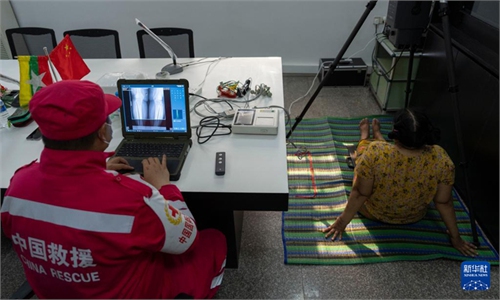
A rescue team member from China's Hong Kong Special Administrative Region government uses a drone to survey the rubble and search for survivors in Mandalay, Myanmar on March 31, 2025. Photo: VCG
In the race against time to save lives following a recent 7.9-magnitude earthquake that struck Myanmar, China's technological capabilities have demonstrated a strong capability for emergency response. Faced with the complex challenges of collapsed buildings, damaged roads and power outages, Chinese rescue teams utilized multiple high-tech equipment to provide crucial support for the rescue operations.
On Saturday, the China International Search and Rescue Team continued to conduct medical outreach in the urban area of Mandalay region, Myanmar. At a relief camp near the University of Medicine in Mandalay, the team's medical personnel utilized self-developed mobile diagnostic equipment such as handheld ultrasound devices, portable X-ray machines and bedside ECG monitors to conduct free examinations for over 250 local residents.
In this international rescue operation, the concept of "science and technology for good" has been vividly exemplified. The Chinese rescue team not only brought professional rescue equipment but, more importantly, also demonstrated a development philosophy that leverages technology to benefit humanity. When drones accurately locate survivors in the ruins, when AI-powered translation services break down language barriers, and when full-function life detectors search for survivors amid the rubble, these applications of technology perfectly embody the value orientation that technological innovation should have - it must serve to enhance rescue efficiency, improve human living conditions, and increase global well-being. This human-centered path of technological development is the core driving force behind the advancement of human civilization.
Today, the world is at a critical juncture of a new technological revolution, and "science and technology for good" should become a consensus. This concept emphasizes that technological innovation should fundamentally aim to enhance overall social efficiency, promote sustainable development and build a community with a shared future for mankind.
China's scientific and technological development has consistently adhered to the concept of "science and technology for good," and has embarked on a unique path of inclusive development. Guided by this principle, China has not only achieved significant improvements in its own development quality through continuous technological innovation and industrial upgrading, but has also promoted global scientific and technological cooperation with an open and inclusive attitude.
From infrastructure construction to the digital economy, and from clean energy to intelligent manufacturing, Chinese science and technology is breaking the barriers of technological monopoly, enabling more developing countries to share in the benefits of scientific and technological development. This open and shared development model not only exemplifies the practice of building a community with a shared future for mankind, but also contributes Chinese wisdom and solutions to global science and technology governance.
In practice, China's international scientific and technological cooperation is all-round and multi-layered. In regions such as Africa and the Middle East, Chinese companies have successfully completed a series of landmark projects, including modern hospitals, large sports stadiums and intelligent transportation hubs, utilizing world-leading construction technologies. Additionally, China's photovoltaic power stations, wind farms, and other projects have provided stable and reliable clean energy to developing countries, especially in the new energy sector, effectively promoting local green and low-carbon transformation.
China's scientific and technological exploration of sustainable development is also worthy of attention. Faced with the environmental challenges brought about by industrialization, China has taken the lead in promoting the transformation of its energy structure through scientific and technological innovation. Currently, China is a global leader in terms of installed capacity for clean energy power generation, and its renewable energy technologies, such as hydropower, wind power and solar power, have reached the world's advanced level. Through practical actions, China is demonstrating that scientific and technological innovation can drive economic development while achieving harmonious coexistence between man and nature.
The healthy development of human civilization should focus on enhancing human survival capabilities, expanding development opportunities, and achieving sustainable development, rather than being constrained by war and pollution. The presence of Chinese technology at the disaster relief site in Myanmar exemplifies the concept of a community with a shared future for mankind.
The author is an observer in the tech field. opinion@globaltimes.com.cn

